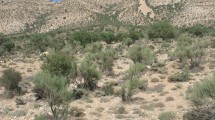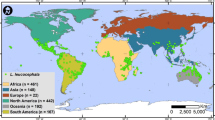Abstract
Climate change is predicted to threaten biodiversity and the distribution and abundance of species. In Africa and other developing regions, changing distributions and abundances of tree species may have profound effects on livelihoods. The aims of the study were to determine the current continuous distribution of African wild loquat (Uapaca kirkiana Müll. Arg., Phyllanthaceae) and to predict the impact of climate change on the future distribution of the species. A maximum entropy method (Maxent) was used to generate models of the current distribution and for projections under different representative concentration pathways (RCPs). After resampling and correlation analysis, models were generated using 84 occurrence records and nine environmental variables. Results showed that the species has a current continuous distribution in the range of miombo woodlands of south-central Africa, in parts of Angola, southern Democratic Republic of Congo, Malawi, Mozambique, Tanzania, Zimbabwe and Zambia. Projections showed suitable habitat contracting under most RCPs in 2050 and 2070. Range contraction was especially acute under a scenario of no mitigation of greenhouse gas emission, that is RCP8.5. In 2050, the range of the species was forecasted to contract by − 13.9% (RCP2.6), − 5.8% (RCP4.5) and − 14.9% (RCP8.5), with a slight expansion of 1.3% under RCP6.0. In 2070, the range was forecasted to contract by − 17.6% (RCP2.6), − 16.4% (RCP4.5), − 3.7% (RCP6.0) and − 20.6% (RCP8.5). Domestication and establishment in protected areas are some options to mitigate against the forecasted contraction of the natural range of the species.




Similar content being viewed by others
References
Aiello-Lammens EM, Boria AR, Radosavljevic A, Vilela B, Anderson PR (2015) spThin: an R package for spatial thinning of species occurrence records for use in ecological niche models. Ecography 38:541–545. https://doi.org/10.1111/ecog.01132
Alexander MJ, Chalmandrier L, Lenoir J, Burgess IT, Essl F, Haider S, Kueffer C, McDougall K, Milbau A, Nuñez MA, Pauchard A, Rabitsch W, Rew LJ, Sanders NJ, Pellissier L (2018) Lags in the response of mountain plant communities to climate change. Glob Chang Biol 24:563–579. https://doi.org/10.1111/gcb.13976
Baek H, Lee J, Lee H, Hyun Y, Cho C, Kwon W, Marzin C, Gan S, Kim M, Choi D, Lee J, Lee J, Boo K, Kang H, Byun Y (2013) Climate change in the 21st century simulated by HadGEM2-AO under representative concentration pathways. Asia-Pacific J Atmos Sci 49:603–618. https://doi.org/10.1007/s13143-013-0053-7
Bitencourt C, Rapinia A, Santos Damascena L, De Marco Jr P (2016) The worrying future of the endemic flora of a tropical mountain range under climate change. Flora 218:1–10. https://doi.org/10.1016/j.flora.2015.11.001
Bogawski P, Damen T, Nowak MM, Pędziwiatr K, Wilkin P, Mwachala G, Pierzchalska J, Wiland-Szymańska J (2019) Current and future potential distributions of three Dracaena Vand. ex L. species under two contrasting climate change scenarios in Africa. Ecol Evol 9:6833–6848. https://doi.org/10.1002/ece3.5251
Bonebrake TC, Brown CJ, Bell JD, Blanchard JL, Chauvenet A, Champion C, Chen I, Clark TD, Colwell RK, Danielsen F, Dell AI, Donelson JM, Evengård B, Ferrier S, Frusher S, Garcia RA, Griffis RB, Hobday AJ, Jarzyna MA, Lee E, Lenoir J, Linnetved H, Martin VY, McCormack PC, McDonald J, McDonald-Madden E, Mitchell N, Mustonen T, Pandolfi JM, Pettorelli N, Possingham H, Pulsifer P, Reynolds M, Scheffers BR, Sorte CJB, Strugnell JM, Tuanmu M, Twiname S, Vergés A, Villanueva C, Wapstra E, Wernberg T, Pecl GT (2018) Managing consequences of climate-driven species redistribution requires integration of ecology, conservation and social science. Biol Rev 93:284–305. https://doi.org/10.1111/brv.12344
Boria AR, Olson EL, Goodman MS, Anderson PR (2014) Spatial filtering to reduce sampling bias can improve the performance of ecological niche models. Ecol Model 275:73–77. https://doi.org/10.1016/j.ecolmodel.2013.12.012
Braedt O, Schroeder JM (2003) Institutions governing the use of forest products: woodcraft commercialisation in southern Africa. For Trees Livelihoods 13:59–78. https://doi.org/10.1080/14728028.2003.9752444
Buri A, Ciafrani C, Pinto-Figueroa E, Yashiro E, Spangenberg JE, Adatte T, Verrecchia E, Guisan A, Pradervand J-E (2017) Soil factors improve predictions of plant species distribution in a mountain environment. Prog Phys Geogr 41:703–722. https://doi.org/10.1177/0309133317738162
Bussotti F, Pollastrini M, Holland V, Bruggemann W (2015) Functional traits and adaptive capacity of European forests to climate change. Environ Exp Bot 111:91–113. https://doi.org/10.1016/j.envexpbot.2014.11.006
Cayuela L, Golicher D, Newton A, Kolb H, de Alburquerque FS, Arets EJMM, Alkemade JRM, Pérez AM (2009) Species distribution modeling in the tropics: problems, potentialities, and the role of biological data for effective species conservation. Trop Conserv Sci 2:319–352. https://doi.org/10.1177/194008290900200304
Chang YW, Wang S, Gaston C, Cool J, An H, Thomas BR (2019) Economic evaluations of tree improvement for planted forests: a systematic review. BioProducts Bus 4:1–14
Chirwa PW, Akinnifesi FK (2007) Ecology and biology of Uapaca kirkiana, Strychnos cocculoides and Sclerocarya birrea in southern Africa. In: Akinnifesi FK, Leakey RRB, Ajayi OC, Sileshi G, Tchoundjeu Z, Matakala P, Kwesiga FR (eds) Indigenous fruit trees in the tropics: domestication, utilization and commercialization. CAB International, London, pp 323–341
Chishimba WK, Mwanabute N (2003) Natural variation in size and soluble solids concentration of Uapaca kirkiana fruit. J Trop For Sci 15:313–319
Condit R, Engelbrecht BMJ, Pino D, Perez R, Turner BL (2013) Species distributions in response to individual soil nutrients and seasonal drought across a community of tropical trees. PNAS 110:5064–5068. https://doi.org/10.1073/pnas.1218042110
Convention on Biological Diversity (1992) Montreal, United Nations
Corlett RT, Westcott DA (2013) Will plant movements keep up with climate change? Trends Ecol Evol 28:482–488. https://doi.org/10.1016/j.tree.2013.04.003
De Cauwer V, Mys B, Revermann R, Trabucco A (2014) Potential, realized, future distribution and environmental suitability for Pterocarpus angolensis DC in southern Africa. For Ecol Manag 315:211–226. https://doi.org/10.1016/j.foreco.2013.12.032
Dimobe K, Quédraogo A, Quédraogo K, Goetze D, Stein K, Schmidt M, Nacoulma BMI, Gnoumou D, Traoré L, Porembski S, Thiombiano A (2020) Climate change reduces the distribution area of the shea tree (Vitellaria paradoxa C.F. Gaertn.) in Burkina Faso. J Arid Environ 181:104237. https://doi.org/10.1016/j.jaridenv.2020.104237
Diniz-Filho JAF, Bini LM, Rangel TF, Loyola RD, Hof C, Nogués-Bravo D, Araujo MB (2009) Partitioning and mapping uncertainties in ensembles of forecasts of species turnover under climate change. Ecography 32:897–906. https://doi.org/10.1111/j.1600-0587.2009.06196.x
Dyderski KM, Paz S, Frelich EL, Jagodzinski MA (2018) How much does climate change threaten European forest tree species distributions? Glob Chang Biol 24:1150–1163. https://doi.org/10.1111/gcb.13925
Elith J, Graham HC (2009) Do they? How do they? Why do they differ? On finding reasons for differing performances of species distribution models. Ecography 32:66–77. https://doi.org/10.1111/j.1600-0587.2008.05505.x
Elith J, Kearney M, Phillips S (2010) The art of modelling range-shifting species. Methods Ecol Evol 1:330–342. https://doi.org/10.1111/j.2041-210X.2010.00036.x
Elith J, Phillips SJ, Hastie T, Dudık M, Chee YE, Yates CJ (2011) A statistical explanation of MaxEnt for ecologists. Divers Distrib 17:43–57. https://doi.org/10.1111/j.1472-4642.2010.00725.x
Escobar LE, Craft ME (2016) Advances and limitations of disease biogeography using ecological niche modeling. Front Microbiol 7:1174. https://doi.org/10.3389/fmicb.2016.01174
Fischer G, Nachtergaele F, Prieler S, van Velthuizen HT, Verelst L, Wiberg D (2008) Global Agro-ecological Zones Assessment for Agriculture (GAEZ 2008). IIASA and FAO, Laxenburg and Rome
Food and Agriculture Organization (FAO) (2020) Global forest resources assessment 2020: Main report. Rome. http://www.fao.org/3/ca9825en/CA9825EN.pdf Accessed 26 July 2020
Fourcade Y, Engler OJ, Rodder D, Secondi J (2014) Mapping species distributions with MAXENT using a geographically biased sample of presence data: a performance assessment of methods for correcting sampling bias. PLoS One 9:e97122. https://doi.org/10.1371/journal.pone.0097122
Friend DJ (1984) Shade adaptation of photosynthesis in Coffea arabica. Photosynth Res 5:325–334
Frost P (1996) The ecology of miombo woodlands. In: Campbell B (ed) The miombo in transition: woodlands and welfare in Africa. Center for International Forestry Research, Bogor, pp 11–57
GBIF (2019) GBIF occurrence download. https://doi.org/10.15468/dl.cfesaa Accessed 29 August 2019
Gent PR, Danabasoglu G, Donner LJ, Holland MM, Hunke EC, Jayne SR, Lawrence DM, Neale RB, Rasch PJ, Vertenstein M, Worley PH, Yang Z, Zhang M (2011) The community climate system model version 4. J Clim 24:4973–4991. https://doi.org/10.1175/2011JCLI4083.1
Goberville E, Beaugrand G, Hautekeete NC, Piquot Y, Luczak C (2015) Uncertainties in the projection of species distributions related to general circulation models. Ecol Evol 5:1100–1116. https://doi.org/10.1002/ece3.1411
Graham CH, Elith J, Hijmans RJ, Guisan A, Peterson AT, Loiselle BA, The Nceas Predicting Species Distributions Working Group (2008) The influence of spatial errors in species occurrence data used in distribution models. J Appl Ecol 45:239–247. https://doi.org/10.1111/j.1365-2664.2007.01408.x
Hickler T, Vohland K, Feehan J, Miller PA, Smith B, Costa L, Giesecke T, Fronzek S, Carter TR, Cramer W, Kühn I, Sykes MT (2012) Projecting the future distribution of European potential natural vegetation zones with a generalized, tree species based dynamic vegetation model. Glob Ecol Biogeogr 21:50–63. https://doi.org/10.1111/j.1466-8238.2010.00613.x
Hijmans RJ (2012) Cross-validation of species distribution models: removing spatial sorting bias and calibration with a null model. Ecology 93:679–688. https://doi.org/10.1890/11-0826.1
Hijmans RJ, Cameron SE, Parra JL, Jones PG, Jarvis A (2005) Very high resolution interpolated climate surfaces for global land areas. Int J Climatol 25:1965–1978. https://doi.org/10.1002/joc.1276
IPCC (2013) Summary for policymakers. In: Stocker TF, Qin D, Plattner GK, Tignor M, Allen SK, Boschung J, Nauels A, Xia Y, Bex V, Midgley PM (eds) Climate change 2013: the physical science basis. Contribution of working group I to the fifth assessment report of the Intergovernmental Panel on Climate Change. Cambridge University Press, Cambridge, pp 3–29
Katsvanga CAT, Gwenzi D, Masuka P, Jimu L, Muhoni L, Moyo M (2007) Characterization of community identified Uapaca kirkiana phenotypes for domestication. J Sustain Dev Afr 9:356–366
Krug JHA (2017) Adaptation of Colophospermum mopane to extra-seasonal drought conditions: site-vegetation relations in dry-deciduous forests of Zambezi region (Namibia). For Ecosyst 4:25. https://doi.org/10.1186/s40663-017-0112-0
Kuhn M (2008) Building predictive models in R using the caret package. J Stat Softw 28:1–26
Kumar D, Tieszen LL (1980) Photosynthesis in Coffea arabica. I. Effects of light and temperature. Exp Agric 16:13–19. https://doi.org/10.1017/S0014479700010656
Lamsal P, Kumar L, Aryal A, Atreya K (2018) Invasive alien plant species dynamics in the Himalayan region under climate change. Ambio 47:697–710. https://doi.org/10.1007/s13280-018-1017-z
Lenoir J, Svenning JC (2015) Climate-related range shifts - a global multidimensional synthesis and new research directions. Ecography 38:15–28. https://doi.org/10.1111/ecog.00967
Loiselle BA, Howell CA, Graham CH, Goerck JM, Brooks T, Smith KG, Williams PH (2003) Avoiding pitfalls of using species distribution models in conservation planning. Conserv Biol 17:1591–1600. https://doi.org/10.1111/j.1523-1739.2003.00233.x
Makhado RA, Potgieter MJ, Wessels DCJ, Saidi AT, Masehela KK (2012) Use of mopane woodland resources and associated woodland management challenges in rural areas of South Africa. Ethnobot Res Appl 10:369–379
Mapaure I (1994) The distribution of Colophospermum mopane (Leguminosae-Caesalpinioideae) in Africa. Kirkia 15:1–5
Meerts P, Farminhão JNM (2019) Uapaca kirkiana (Phyllanthaceae) and its relatives in the northwest of the Zambezian region. Kew Bull 74:38. https://doi.org/10.1007/s12225-019-9826-1
Mendelsohn R, Dinar A, Williams L (2006) The distribution impact of climate change on rich and poor countries. Environ Dev Econ 11:159–178. https://doi.org/10.1017/S1355770X05002755
Moat J, Gole TW, Davis AP (2019) Least concern to endangered: applying climate change projections profoundly influences the extinction risk assessment for wild Arabica coffee. Glob Chang Biol 25:390–403. https://doi.org/10.1111/gcb.14341
Morton FJ (2007) The impact of climate change on smallholder and subsistence agriculture. PNAS 11:19680–19685. https://doi.org/10.1073/pnas.0701855104
Mwase FW, Bjørnstad A, Stedje B, Bokosi JM, Kwapata MB (2006) Genetic diversity of Uapaca kirkiana Muel. Årg. populations as revealed by amplified fragment length polymorphisms (AFLPs). Afr J Biotechnol 5:1205–1213
Mwase FW, Akinnifesi FK, Stedje B, Kwapata MB, Bjørnstad A (2010) Genetic diversity within and among southern African provenances of Uapaca kirkiana Muel. Årg. using morphological and AFLP markers. New For. https://doi.org/10.1007/s11056-010-9206-z
Nenzen HK, Araujo MB (2011) Choice of threshold alters projections of species range shifts under climate change. Ecol Model 222:3346–3354. https://doi.org/10.1016/j.ecolmodel.2011.07.011
Ngulube MR (2000) Population structures of Uapaca kirkiana (Euphorbiaceae) in the miombo woodlands of Malawi: status and management prospects for fruit production. J Trop For Sci 12:459–471
Ngulube MR, Hall JB, Maghembe JA (1995) Ecology of a miombo fruit tree: Uapaca kirkiana (Euphorbiaceae). For Ecol Manag 77:107–118. https://doi.org/10.1016/0378-1127(95)03572-R
Ngulube MR, Hall JB, Maghembe JA (1996) A review of the silviculture and resource potential of a miombo fruit tree: Uapaca kirkiana (Euphorbiaceae). J Trop For Sci 8:395–411
Ngulube MR, Hall JB, Maghembe JA (1998) Reproductive ecology of Uapaca kirkiana (Euphorbiaceae) in Malawi, southern Africa. J Trop Ecol 14:743–760
Nozawa T, Nagashima T, Yokohata T, Okada N, Shiogama H (2007) Climate change simulations with a coupled ocean-atmosphere GCM called the Model for Interdisciplinary Research on Climate, MIROC. Center for Global Environmental Research. National Institute for Environmental Studies, Tsukuba, Japan
Oke AO, Thompson AK (2015) Distribution models for mountain plant species: the value of elevation. Ecol Model 301:72–77. https://doi.org/10.1016/j.ecolmodel.2015.01.019
Parmesan C (2006) Ecological and evolutionary responses to recent climate change. Annu Rev Ecol Evol Syst 37:637–669. https://doi.org/10.1146/annurev.ecolsys.37.091305.110100
Pearson RG, Dawson TP (2003) Predicting the impacts of climate change on the distribution of species: are bioclimate envelope models useful? Glob Ecol Biogeogr 12:361–371. https://doi.org/10.1046/j.1466-822X.2003.00042.x
Pearson RG, Raxworthy CJ, Nakamura M, Peterson AT (2007) Predicting species distributions from small numbers of occurrence records: a test case using cryptic geckos in Madagascar. J Biogeogr 34:102–117. https://doi.org/10.1111/j.1365-2699.2006.01594.x
Phillips SJ (2008) A brief tutorial on Maxent. AT&T Research
Phillips SJ, Dudik M (2008) Modeling of species distributions with MaxEnt: new extensions and a comprehensive evaluation. Ecography 31:161–175. https://doi.org/10.1111/j.0906-7590.2008.5203.x
Phillips SJ, Anderson RP, Schapire RE (2006) Maximum entropy modeling of species geographic distributions. Ecol Model 190:231–259. https://doi.org/10.1016/j.ecolmodel.2005.03.026
Pienaar B, Thompson DI, Erasmus BFN, Hill TR, Witkowski ETF (2015) Evidence for climate-induced range shift in Brachystegia (miombo) woodland. S Afr J Sci 111:1–9. https://doi.org/10.17159/SAJS.2015/20140280
Quintana M, Salomon O, Guerra R, Lizarralde De Grosso M, Fuenzalida A (2013) Phlebotominae of epidemiological importance in cutaneous leishmaniasis in northwestern Argentina: risk maps and ecological niche models. Med Vet Entomol 27:39–48. https://doi.org/10.1111/j.1365-2915.2012.01033.x
R Development Core Team (2019) R: a language and environment for statistical computing. R Foundation for Statistical Computing. http://www.r-project.org/
Ratcliffe B, El-Dien OG, Cappa EP, Porth I, Klápste J, Chen C, El-Kassaby YA (2017) Single-step BLUP with varying genotyping effort in open-pollinated Picea glauca. G3 7:935–942. https://doi.org/10.1534/g3.116.037895
Revermann R, Gomes AL, Gonçalves FM, Wallenfang J, Hoche T, Jürgens N, Finckh M (2016) Vegetation database of the Okavango Basin. Phytocoenologia 46:103–104. https://doi.org/10.1127/phyto/2016/0103
Sanchez AC, Osborne PE, Haq N (2011) Climate change and the African baobab (Adansonia digitata L.): the need for better conservation strategies. Afr J Ecol 49:234–245. https://doi.org/10.1111/j.1365-2028.2011.01257.x
Thornton PK, van de Steeg J, Notenbaert A, Herrero M (2009) The impacts of climate change on livestock and livestock systems in developing countries: a review of what we know and what we need to know. Agric Syst 101:113–127. https://doi.org/10.1016/j.agsy.2009.05.002
van Vuuren DP, Edmonds J, Kainuma M, Riahi K, Thomson A, Hibbard K, Hurtt GC, Kram T, Krey V, Lamarque J, Masui T, Meinshausen M, Nakicenovic N, Smith SJ, Rose SK (2011) The representative concentration pathways: an overview. Clim Chang 109:5–31. https://doi.org/10.1007/s10584-011-0148-z
Veloz SD (2009) Spatially autocorrelated sampling falsely inflates measures of accuracy for presence-only niche models. J Biogeogr 36:2290–2299. https://doi.org/10.1111/j.1365-2699.2009.02174.x
Werden KL, Becknell MJ, Powers SJ (2018) Edaphic factors, successional status, and functional traits drive habitat associations of trees in naturally regenerating tropical dry forests. Funct Ecol 32:2766–2776. https://doi.org/10.1111/1365-2435.13206
White F (1983) The vegetation of Africa. Natural Resources Research 20. UNESCO, Paris
Acknowledgements
We would like to thank P. Meerts and J. N. M. Farminhão of the Université Libre de Bruxelles for providing occurrence records from west south-central Africa. Appreciation also goes to R. Revermann and M. Finckh who provided occurrence records from the Vegetation Database of the Okavango Basin and E. N. Chidumayo of the Makeni Savanna Research Project for Zambian occurrence records.
Funding
This study was funded by the Biological Sciences Department at the Bindura University of Science Education.
Author information
Authors and Affiliations
Corresponding author
Ethics declarations
Conflict of interest
The authors declare that they have no conflict of interest.
Additional information
Communicated by Wolfgang Cramer
Publisher’s note
Springer Nature remains neutral with regard to jurisdictional claims in published maps and institutional affiliations.
Rights and permissions
About this article
Cite this article
Jinga, P., Palagi, J., Chong, J.P. et al. Climate change reduces the natural range of African wild loquat (Uapaca kirkiana Müll. Arg., Phyllanthaceae) in south-central Africa. Reg Environ Change 20, 108 (2020). https://doi.org/10.1007/s10113-020-01700-y
Received:
Accepted:
Published:
DOI: https://doi.org/10.1007/s10113-020-01700-y




